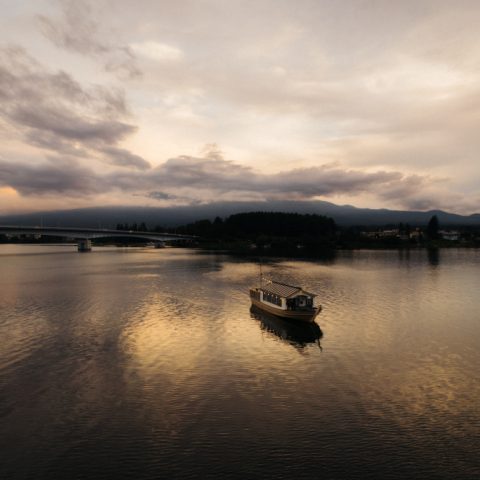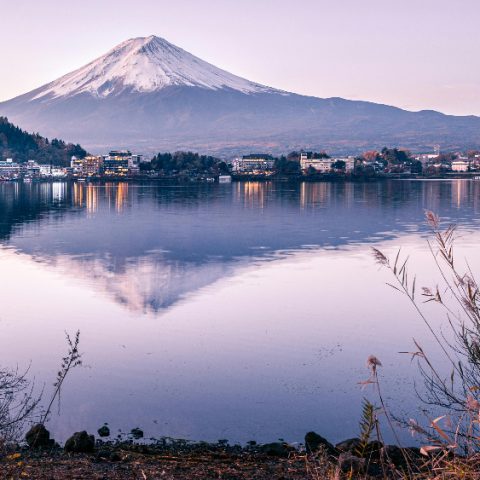
There are very few landmarks that are universally recognized and revered across the world, and there are none more easily recognized than Mt. Fuji. When discussing Japan, you can’t avoid Mt. Fuji: the mountain is synonymous with the country. It is one of the most popularly photographed and artistically depicted mountains in the entire world, rivaled only by the tallest mountain on the planet, Mt. Everest. But what makes this mountain on the island nation of Japan so special?
The Beauty of Mt. Fuji
First and foremost, while not the tallest mountain in the world, Mt. Fuji is the tallest mountain in Japan, standing at 3,776 km (12,380 ft) tall! Additionally, it has an incredibly wide base at 500 m (1,600 ft) wide, and is surrounded by 5 lakes, which means that it can be clearly viewed from far away, even from up to 300 km (186.41 mi) away. This creates the opportunity for beautiful photographs as well as gorgeous views from which to paint or draw the landscape.
However, the peak of Mt. Fuji can’t always be seen. The peak is often covered by clouds, and some people have even reported not being able to see the peak in person for years despite living in Japan their whole lives! However, this does not detract from the beauty of Mt. Fuji. If anything, it adds to the mystery and intrigue: making those times that you can see the peak more special. This does not mean that seeing Mt. Fuji covered in clouds is necessarily a bad thing. Far from it in fact. Many photos and art pieces depicting Mt. Fuji have the peak covered in clouds and are still breathtaking sights. For instance, just recently, many photographed the peak due to the “miraculous” cloud covering the peak, in which the cloud appeared like a multi-layered disk. It’s a beautiful sight, as pictured below!

Photo from @planetx44 on Twitter.
A Hiker’s Dream
On top of being a great view, Mt. Fuji is one of the most heavily visited mountains for those who love mountain climbing. People come from all over the world for the opportunity to climb to the peak of Mt. Fuji to see the gorgeous view from the other side. It’s even so popular that it’s on the to-do list of many people who usually have no interest in mountain climbing (myself included, I’m hoping to make the climb someday in the future).
The most people who have attempted it in a single year reached a staggering 320,000 people in 2010, while the average usually stays around 300,000 per year. The historical reasons for climbing Mt. Fuji were in part because it was seen as an act of purification in both Buddhism and Shintoism, but the popularity of the climb has only grown in modern times. These days, some people still pursue the climb for those reasons, but everyone has their own distinct motivation. Some want to climb mountains all over the world, others want to test out their personal fitness level, and still others love Japan and want to see the country from its highest point. Whatever the reason may be, the act of climbing Mt. Fuji is a special task with a lot of personal and cultural meaning.
Tips for Making the Climb

Painting by Utagawa Hiroshige – Japanese artist from the Edo period
Are you like me and want to climb this legendary mountain one day? Let me share with you some tips and advice that I’ve found through my own research. First and most importantly: it’s not a race. There’s no need to try to rush to the peak. Take your time and be aware of your own condition while you’re going up. The official climbing season runs from early July until the middle of September, so you’ll probably be wearing clothes for warm weather at the bottom, like shorts and a t-shirt. However, you should make sure to pack warmer clothes, since it gets colder the closer you get to the top.
The climb itself can take anywhere from 5 to 10 hours depending on which trail you choose to take. This average time doesn’t take into consideration breaks at any of the stations though and is not representative of the time it would take to climb at a relaxed pace. Many people recommend splitting the climb into a two-day trip, rather than rushing it and trying to finish it all in one day. You can sign up for a two-day tour where there are accommodations for you to stay overnight along the trails. While the Yoshida trail is the most popular and is certainly a good trail for beginners due to the frequency of stops and the emergency hut, don’t be afraid to take the Subashiri trail if you want to take the trail less traveled. It is not excessively difficult for a first-time climber, and it has much more variance in the views you’ll see along the way.

If you’re confident in your ability, feel free to take either of the other trails, but these two are the most highly recommended trails for first-time climbers and beginners. Be aware the Subashiri trail takes a bit longer than the Yoshida trail, but if that’s fine with you, it’s definitely worth a try! Descending the mountain from the top takes about half as long as the ascent, but be warned: many people say that the descent is actually more difficult and a bit more dangerous. It’s of the utmost importance to be careful and watch your step on the descent, as there is a lot of loose rubble and it would be easy to slip if you aren’t paying attention. Lastly, be sure to bring the proper gear and be in proper physical condition. I encourage you to look into what types of gear you need to purchase or rent before the climb on your own, as it is one of the most important factors in your climb.
The climb starts from the 5th station, and hikers usually reach this station via car or bus. However, the Yamanashi prefectural officials have been discussing starting construction on a railway project from the foot of the mountain to the 5th station with the intention of removing vehicle traffic along the route. This is in part of the efforts to reduce the exhaust gasses being produced through travel along the route, and would make the journey to the 5th station even more streamlined for hikers. This is an exciting project that would be a plus for the environment as well as anyone wanting to climb to the peak! While nothing has been confirmed yet, this is a project you should definitely keep your eyes on.

Photo Source: Kirill Petropavlov on Unsplash
The Surrounding Area
In addition to Mt. Fuji itself, the two surrounding prefectures Yamanashi and Shizuoka have a ton of fun things to do and their own unique food to try. The culture of these two prefectures ensure that you will have a great time on your trip to Mt. Fuji. If you’re interested in learning about the food and experiences you can have in the area, I highly recommend checking out our Discover Mt. Fuji: Online Experience! I personally have sat in on the tour twice now, and it’s a fun tour that’s constantly engaging, jam-packed with information, and has a plethora of pictures of Mt. Fuji and the region surrounding it! Learn more here: Discover Mt. Fuji: Online Experience.





